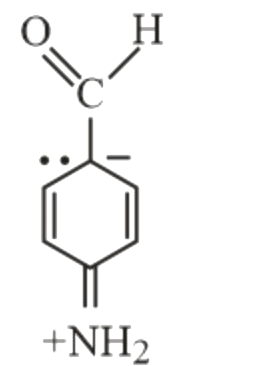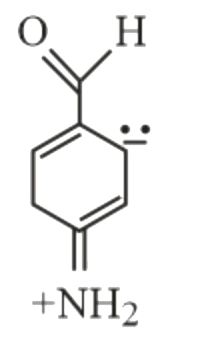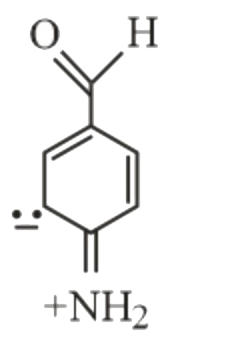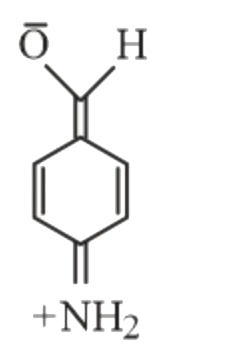Which of the following is not a resonance form of para-amino-benzaldehyde ?




The correct Answer is:B
To determine which of the given options is not a resonance form of para-amino-benzaldehyde, we first need to understand the structure of para-amino-benzaldehyde and its possible resonance forms.
1. Identify the Structure of Para-Aminobenzaldehyde:
- Para-amino-benzaldehyde consists of a benzene ring with an amino group (-NH2) at the para position relative to the aldehyde group (-CHO).
- The structure can be represented as:
NH2∣C6H4−CHO
2. Draw the Resonance Structures:
- The resonance structures can be drawn by shifting the lone pair of electrons and pi bonds.
- One possible resonance structure involves the lone pair on the nitrogen atom forming a double bond with the carbon atom of the benzene ring, while the double bond between the carbon and oxygen in the aldehyde shifts to form a negative charge on the oxygen:
+NH2∣∣C6H4−C−−OH
- Another resonance structure can be formed by shifting the double bond from the carbonyl (C=O) to the nitrogen, resulting in:
NH2+∣∣C6H4−C−O−
3. Analyze the Given Options:
- We need to evaluate each option to see if it can be a valid resonance form.
- If any structure shows a carbon atom with a valency greater than 4 (i.e., pentavalent), it cannot be a valid resonance structure.
4. Evaluate Each Option:
- Option 1: Valid resonance structure (as derived).
- Option 2: This structure shows a carbon atom with five bonds (pentavalent), which is not possible. Therefore, this is not a valid resonance structure.
- Option 3: Valid resonance structure (similar to the ones derived).
- Option 4: Valid resonance structure (as derived).
5. Conclusion:
- The option that is not a resonance form of para-amino-benzaldehyde is Option 2, as it depicts a carbon atom with a valency of 5, which is not feasible.
Final Answer:
Option 2 is not a resonance form of para-amino-benzaldehyde.
- Para-amino-benzaldehyde consists of a benzene ring with an amino group (-NH2) at the para position relative to the aldehyde group (-CHO).
- The structure can be represented as:
NH2∣C6H4−CHO
- The resonance structures can be drawn by shifting the lone pair of electrons and pi bonds.
- One possible resonance structure involves the lone pair on the nitrogen atom forming a double bond with the carbon atom of the benzene ring, while the double bond between the carbon and oxygen in the aldehyde shifts to form a negative charge on the oxygen:
+NH2∣∣C6H4−C−−OH
- Another resonance structure can be formed by shifting the double bond from the carbonyl (C=O) to the nitrogen, resulting in:
NH2+∣∣C6H4−C−O−
- We need to evaluate each option to see if it can be a valid resonance form.
- If any structure shows a carbon atom with a valency greater than 4 (i.e., pentavalent), it cannot be a valid resonance structure.
- Option 1: Valid resonance structure (as derived).
- Option 2: This structure shows a carbon atom with five bonds (pentavalent), which is not possible. Therefore, this is not a valid resonance structure.
- Option 3: Valid resonance structure (similar to the ones derived).
- Option 4: Valid resonance structure (as derived).
- The option that is not a resonance form of para-amino-benzaldehyde is Option 2, as it depicts a carbon atom with a valency of 5, which is not feasible.
Option 2 is not a resonance form of para-amino-benzaldehyde.
Similar Questions
Knowledge Check
Which of the following is an amino acid?
ASerineBAlanineCTyrosineDLysineWhich of the following is pair of resonance structure?
A B
B C
C D
D
Which of the following is not a permissible resonating form?
AH2⊕C−..N∣CH3−өOBCH2=⊕N∣CH3−өOCCH2=⊕N∣CH3=ODөCH2−⊕N∣CH3=O
Which of the following is not a resonance structure of the other?
View SolutionWhich of the following is not an α-amino acid?
View SolutionWhich one is not a resonance form of a phenolate ion?

View SolutionWhich of the following is an essential amino acid?
View SolutionWhich of the following is not a resonance structure of the other?
View Solution
